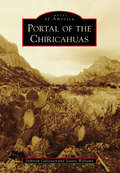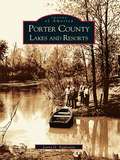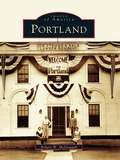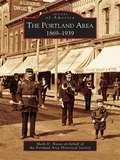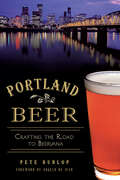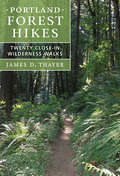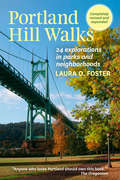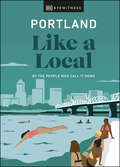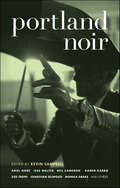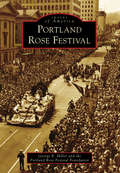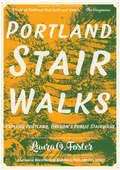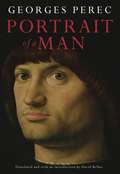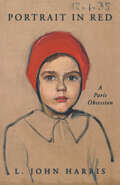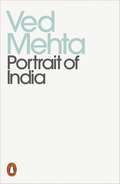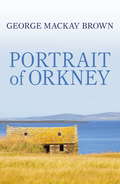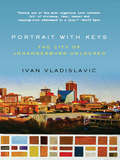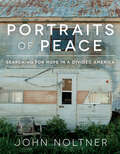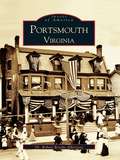- Table View
- List View
Portal of the Chiricahuas (Images of America)
by Jeanne Williams Deborah GallowayCoronado scorned this region as unpopulated when he labored through southeastern Arizona in 1540, but he could have found 12,000-year-old spear points in the remains of giant bison near Cave Creek Cienega, grinding hollows in boulders, and shamanic figures in high caves of the Chiricahuas towering above valleys and grasslands. Searing drought forced people to abandon their villages by 1400, but Apaches wandered down from Canada about the time Spaniards passed by. Thousands of forty-niners traveled in sight of the mountains on their race to California. The Chiricahua Apaches were exiled to Florida in 1886; even earlier, their lands were opened to settlement. Portal began in 1902 as a rest stop between the railroad and the boom town of Paradise. Since 1956, the Southwestern Research Station of the American Museum of Natural History has attracted countless researchers. The present community is a vibrant mix of biologists, birders, astronomers, writers, artists, and ranchers, united by love for this unique canyon.
Porter County Lakes and Resorts
by Larry G. EgglestonThe history of Porter County goes back several centuries. The area now known as Porter County was first inhabited by several Indian tribes, primarily the Potawatomi. With the formation of the state of Indiana and the establishment of Porter County, the area grew rapidly. The natural beauty of Porter County and its scenic freshwater lakes attracted developers who erected several summer resorts around the lake area. Access to these resorts was enhanced by the construction of the interurban electric railroad, which offered visitors easy access to the area's offerings.
Portland
by Robert W. McdougallPortland is located in "the big bend" of the Connecticut River near the center of the state, where natural resources provided a prosperous livelihood for generations of residents. First settled as part of Middletown, the area was incorporated as Portland in 1841. The town is known for its brownstone quarries, the Gildersleeve shipyard, and shade-grown tobacco. Meshomasic, the first state forest in New England, is located here. In Portland, historic photographs drawn from the archives of the Portland Historical Society and from private collections take the reader on a journey through the rich history of this quiet small town, now known for its golf courses and marinas.
Portland Area, The: 1869-1939
by Portland Area Historical Society Mark D. NeeseIn the early 1830s, a man named Elisha Newman made the first land claim in the area that later became Portland, Michigan. Newman was attracted by the excellent location at the confluence of the Grand and Looking Glass Rivers. He was not the first to be drawn to this area, as it had already been occupied for many years by the Chippewa and Ottawa tribes of Native Americans. After its 1836 settlement by European Americans, Portland steadily grew into an economic and industrial center of Ionia County. In 1869, Portland was incorporated as a village. This book contains nearly 200 photographs and illustrations that both document and celebrate life in the Portland area from 1869 through the years just prior to World War II, a time when the banks of the Grand and Looking Glass Rivers were teeming with industry and the downtown streets were bustling with activity.
Portland Beer: Crafting the Road to Beervana (American Palate Ser.)
by Pete Dunlop&“Takes a look at Portland, Oregon&’s rich history of not just craft beer brewing but also its appreciation for the foodie and bar culture.&” —Brewpublic Was it the water or the quality hops? The deep-rooted appreciation of saloon culture? How did Portland, Oregon, become one of the nation&’s leaders in craft beer cultivation and consumption, with more than fifty breweries in the city limits? Beer writer and historian Pete Dunlop traces the story of Rose City brewing from frontier saloons, through the uncomfortable yoke of temperance and Prohibition, to the hard-fought Brewpub Bill and the smashing success of the Oregon Brewers Festival. Meet the industry leaders in pursuit of great beer—Henry Weinhard, McMenamins, Bridgeport, Portland Brewing, Widmer and more—and top it off with a selection of trivia and local lore. Bringing together interviews and archival materials, Dunlop crafts a lively and engaging history of Portland&’s road to Beervana.
Portland Family Adventures: City Escapades, Day Trips, Weekend Getaways, and Itineraries for Fun-Loving Families
by Jen StevensonDiscover Portland’s best family-friendly outings, activities, attractions, and day trips in this complete, portable guide to family fun.The Family Adventures guides are must-haves for local parents and visitors, as well as babysitters and other family members who want to explore Portland, Seattle, and the surrounding areas with kids. These go-to guides offer comprehensive ideas and listings appropriate for a wide array of ages, from babies and toddlers to young teens. Activities range from exploring children’s museums and other hands-on creative destinations to hiking, swimming, and ziplining, as well as visiting libraries, zoos, playgrounds, and much more, including where to find the best ice cream! Bursting with relevant, reliable information and tips, as well as itineraries for one day or more, these guides will take the place of hours of tedious online research. Instead you’ll find everything you need to know in one book that you can also pop into a bag or stroller and bring along with you. Whether you unexpectedly have a couple of free hours or want to plan a weekend away, grab a Family Adventures guide and make some amazing memories with your kids!From the Trade Paperback edition.
Portland Farmers Market Cookbook: 100 Seasonal Recipes and Stories that Celebrate Local Food and People
by Ellen JacksonThe Portland Farmers Market is a year-round farmers market consistently named among North America's Top Ten. This cookbook is a tribute to the farmers, chefs and shoppers, who embrace their world-class market like no other. With 100, seasonally organized recipes for every meal of the day, stories of the market's farmers and producers, shopping and cooking tips, and glorious color photography, the Portland Farmers Market Cookbook is a celebration of a place and its people, who are proud to share their bounty with the Portland community and beyond.From the Trade Paperback edition.
Portland Forest Hikes: Twenty Close-In Wilderness Walks
by James D. ThayerHere are twenty wilderness hikes within twenty miles of downtown Portland, Oregon, less than a half hour's ride from the city. Adventurers at all skill levels will be surprised by the remoteness and remarkable beauty of these easy woodland escapes. Just take this pocket-sized companion and slip down a hidden trail to emerge on vistas with eagles soaring overhead. There are shorter walks suitable for kids, like the McCarthy Creek Loop, and rugged routes for the ambitious, like the Fire Lane 12 loop. Each hike description includes a map, bus access, basic conditions, length, and grade, as well as flora, fauna, geology, and local history. Half the trails explore lesser-known wooded hillsides in Forest Park. Others venture farther north in the Tualatin Mountains into rarely described prime Oregon hiking country. A devoted advocate for Portland's wilderness areas, James D. Thayer has surveyed most of the publicly accessible walking routes along the Tualatin Mountains from Forest Park to Scappoose and nearly to the Oregon coast-on foot.
Portland Hill Walks: 24 Explorations in Parks and Neighborhoods, Completely Revised and Expanded
by Laura O. FosterPortland Hill Walks features twenty-four miniature adventures stocked with stunning views, hidden stairways, leafy byways, urban forests, and places to sit, eat, and soak in the local scene. The revised and updated edition offers five new walks in addition to the well-loved classics, with new contemporary and historical photos and easier-to-follow directions.Whether you feel like meandering through old streetcar neighborhoods or climbing a lava dome, there is a hill walk for every mood. New walks take you up to Willamette Stone State Park, across the St. Johns Bridge, down to the South Waterfront (with a ride on the aerial tram), along a stream in Gresham, and up Mounts Talbert and Scott.Portland is a walking city, and Portland Hill Walks will inspire you to enjoy it to its fullest!
Portland Like a Local: By the People Who Call It Home (Local Travel Guide)
by DK Eyewitness Alex Frane Jenni Moore Pete CottellKeen to explore a different side of Portland? Like a Local is the book for you.This isn&’t your ordinary travel guide. Beyond Portland&’s iconic food trucks are hidden comic stores, eclectic dive bars and quirky galleries that locals love – and that&’s where this book takes you. Turn the pages to discover: The small businesses and community strongholds that add character to this vibrant city, recommended by true locals.6 themed walking tours dedicated to specific experiences such as vintage shopping and waterfront walks.A beautiful gift book for anyone seeking to explore Portland.Helpful &‘what3word&’ addresses, so you can pinpoint all the listed sights.Compiled by three proud Portlanders, this stylish travel guide is packed with Portland&’s best experiences and hidden spots, handily categorized to suit your mood and needs.Whether you&’re a restless Portlander on the hunt for a new hangout, or a visitor keen to discover a side you won&’t find in traditional guidebooks, Portland Like A Local will give you all the inspiration you need. About Like A Local:These giftable and collectible guides from DK Eyewitness are compiled exclusively by locals. Whether they&’re born-and-bred or moved to study and never looked back, our experts shine a light on what it means to be a local: pride for their city, community spirit and local expertise. Like a Local will inspire readers to celebrate the secret as well as the iconic – just like the locals who call the city home. Looking for another guide to Portland? Explore further with our DK Eyewitness guide to the Pacific Northwest.
Portland Noir (Akashic Noir #0)
by Kevin SampsellExplore the dark, rainy underbelly of one of America's most beautiful but enigmatic cities.Akashic Books continues its groundbreaking series of original noir anthologies, launched in 2004 with Brooklyn Noir. Each story is set in a distinct neighborhood or location within the city of the book.Brand-new stories by: Gigi Little, Justin Hocking, Christopher Bolton, Jess Walter, Monica Drake, Jamie S. Rich (illustrated by Joëlle Jones), Dan DeWeese, Zoe Trope, Luciana Lopez, Karen Karbo, Bill Cameron, Ariel Gore, Floyd Skloot, Megan Kruse, Kimberly Warner-Cohen, and Jonathan Selwood.From the introduction by Kevin Sampsell:“Settled in 1843 and named by a coin flip (we were almost named Boston), Portland had troubles from the start. The first sheriff, William Johnson, was busted for selling ‘ardent spirits.’ He had been ‘reduced by an evil heart,’ said the indictment. The first couple of decades were probably pretty rough, what with the constant flooding and muddy streets making all the citizens cranky . . . Later, in the 1940s and ’50s, the city practically thrived on criminal activity. Speakeasies, brothels, and gambling dens popped up across the downtown area . . . Portland became known as quite the decadent town, even prompting Bobby Kennedy to wrangle up its main bad guys for a televised Racketeering Committee meeting in 1957. One senator said at the hearings, ‘If I lived there, I would suggest they pull the flags down to half-mast in public shame.’A lot of these places of ‘shame’ remain standing, and while many are occupied now by salons and offices, some of them are probably still home to gambling and stripping. (Portland does, after all, have more strip clubs per capita than any other city in America—and yep, they take it all off here.) . . . Portland continues to update its own version of a contemporary utopian society as more and more people flock here. But even in utopia, crime and unrest are always bubbling right under the surface.“
Portland Rose Festival (Images of America)
by George R. Miller Portland Rose Festival FoundationAt the end of the Lewis and Clark Exposition in 1905, the president of the Portland Street Fair and Carnival Association, E.W. Rowe, presented the idea of an annual festival to Portland mayor Harry Lane. From that idea came the first Rose Festival, called the Rose Carnival and Fiesta, held June 20-22, 1907. It was hailed as a huge success. "There is no reason in the world why Portland should not hold a rose festival every year," remarked the Oregonian on June 21. "Everyone will be happier and better all the rest of the year for the festival of roses." And indeed, that has been the case. From just a three-day event, the Rose Festival has expanded over the years to include many activities covering several months every spring and summer.
Portland Stair Walks: Explore Portland, Oregon's Public Stairways
by Laura O. FosterWhy is it so satisfying to walk up and down stairs? Maybe it's the new layer of discovery with each step up—a new far-off view and a new close-up look at the plants and buildings. Maybe it's the fleeting proximity one has to passing strangers. Maybe it's the great feeling of propelling yourself upward and then floating downward. Maybe it's the best workout you can get without putting on gym clothes. Whatever the reason, stairs are an excellent way to get yourself up or down a landscape, and Portland, Oregon has a whole lot of them built into our public sidewalk and trail infrastructures.
Portland, Oregon Chef's Table: Extraordinary Recipes from the City of Roses (Chess Classics)
by Laurie WolfPortland, Oregon Chef&’s Table celebrates the food and culture of what the New York Times calls the city&’s &“Golden Age&” of dining and drinking. The city&’s food scene—largely a celebration of the farm-to-table movement—has grown and evolved tremendously in the last five years, with an abundance of local farms, fisheries, and small beef, lamb, and pork producers providing the city&’s iconic restaurants with a wide array of locally-grown deliciousness. Portland, Oregon Chef&’s Table is the first cookbook to gather Portland&’s top chefs and restaurants under one cover. With over seventy recipes for the home cook from more than sixty of the city&’s most celebrated restaurants and showcasing stunning full-color photos from award-winning photographer Bruce Wolf, featuring mouth-watering dishes, famous chefs, and lots of local flavor, Portland, Oregon Chef&’s Table is the ultimate gift and keepsake cookbook for both the tourist and the Portland local.
Portland, Oregon Food Crawls: Touring the Neighborhoods One Bite and Libation at a Time (Food Crawls)
by Nicole Piech-Gitenstein Eric GitensteinPortland, Oregon Food Crawls is an exciting culinary tour through Rose City. Discover hidden gems and long-standing institutions of this Pacific Northwest mecca. Each crawl is the complete recipe for a great night out, the perfect tourist day, a new way to experience your own city, or simply food porn to enjoy from home. Check out the hipster hot spots along North Mississippi and the mom-and-pop shops on Fremont. Then elevate your dining experience with nationally known restaurants nestled in downtown hotels. Put on your walking shoes and your stretchy pants, and dig into Portland one dish at a time.
Portrait Of A Man
by Georges PerecGaspard Winckler, master forger, is trapped in a basement studio on the outskirts of Paris, with his paymaster's blood on his hands. The motive for this murder? A perversion of artistic ambition. After a lifetime lived in the shadows, he has strayed too close to the sun. Fittingly for such an enigmatic writer, Portrait of a Man is both Perec's first novel and his last. Frustrated in his efforts to find a publisher, he put it aside, telling a friend: 'I'll go back to it in ten years when it'll turn into a masterpiece, or else I'll wait in my grave until one of my faithful exegetes comes across it in an old trunk.' An apt coda to one of the brightest literary careers of the twentieth century, it is - in the words of David Bellos, the 'faithful exegete' who brought it to light - 'connected by a hundred threads to every part of the literary universe that Perec went on to create - but it's not like anything else that he wrote.
Portrait in Red: A Paris Obsession
by L. John HarrisThe quest to uncover the history of a mysterious painting, and a joyous exploration of art in the twentieth century and beyond.While wandering the streets of Paris in 2015, L. John Harris finds an abandoned, unfinished, and strangely compelling painting. The subject: a girl wearing a bright-red head covering, fixing her viewer with a foreboding gaze. The painting bears no signature, only the date: January 12, 1935. Harris, a journalist and illustrator, embarks on a multi-year quest to uncover the story behind this painting. His sleuthing has given birth to Portrait in Red, a wide-ranging exploration of art and its enduring mysteries.With wit and a contagious enthusiasm, Harris traces unexpected connections between Paris on the eve of World War II, his bohemian life in the San Francisco Bay Area, the aura of original paintings, the magic of found objects, and the aesthetics of a perfect croque monsieur. Portrait in Red will delight lovers of Edmund de Waal's The Hare with Amber Eyes or Michael Finkel's The Art Thief. By turns heartbreaking and laugh-out-loud funny, it is an existential detective story, set among world tragedies, art-historical epiphanies, and comic hijinks.
Portrait of India (Penguin Modern Classics)
by Ved MehtaReturning to 1960s' India after decades beyond its borders, Ved Mehta explores his native country with two sets of eyes: those of the man educated in the West, and those of the child raised under the Raj. Travelling from the Himalayas in the east to Kerala in the west, Ved Mehta's observations and insights into India and some of its most interesting figures - including Indira Gandhi, Jaya Prakash Narayan and Satyajit Ray - create one of the twentieth century's most thought-provoking travel memoirs.
Portrait of Orkney
by George BrownA vivid portrait of the island that inspired his work from one of Scotland's greatest poets.
Portrait of Orkney
by George Mackay Brown George Mackay BrownPortrait of Orkney is a personal account of a people, their history and their way of life, and of a landscape that has shaped them, and been shaped by them.
Portrait of an Explorer: Hiram Bingham, Discoverer of Machu Picchu
by Alfred M. BinghamDetails about Hiram Bingham's exploration in Peru that led him to Machu Picchu.
Portrait with Keys: The City of Johannesburg Unlocked
by Ivan Vladislavic"Surely one of the most ingenious love letters--full of violence, fear, humour, and cunning--ever addressed to a city." --Geoff Dyer This dazzling portrait of Johannesburg is one of the most haunting, poetic pieces of reportage about a metropolis since Suketu Mehta's Maximum City. Through precisely crafted snapshots, Ivan Vladislavic observes the unpredictable, day-today transformation of his embattled city: the homeless using manholes as cupboards, a public statue slowly cannibalized for scrap. Most poignantly he charts the small, devastating changes along the postapartheid streets: walls grow higher, neighborhoods are gated off, the keys multiply. Security--insecurity?--is the growth industry. Vladislavic, described as "one of the most imaginative minds at work in South African literature today" (André Brink), delivers "one of the best things ever written about a great, if schizophrenic, city, and an utterly true picture of the new South Africa" (Christopher Hope).
Portraits from Paris: School and Travel Remembered from the City of Light
by Gavin Cologne-BrookesWritten between 2019 and 2024, Portraits from Paris is a novelized memoir of a boarding-school childhood in 1970s England, interspersed with journalistic sketches of cities as diverse as Montevideo, Kolkata, and Moscow that draw from the travel-studded years between school and the author’s move to France. Along the way, Gavin Cologne-Brookes reflects on historic events ranging from Brexit, the COVID-19 pandemic, and the Russian invasion of Ukraine to the death of the queen, the restoration of Notre-Dame, and the Paris Olympics. Binding the personal and political together is an oil painter’s rendering of his creative evolution, building with careful brushwork upon the tints of the craft’s discovery in adolescence to arrive at the nuanced hues of artistic maturity.
Portraits of Peace: Searching for Hope in a Divided America
by John NoltnerFrustrated with an increasingly polarized social landscape, award-winning photographer John Noltner set out on a 40,000-mile road trip across the United States to rediscover the common humanity that connects us. He did so by asking people one simple question: "What does peace mean to you?" Through difficult conversations, gentle humor, and a keen eye for beauty, Noltner's Portraits of Peace captures a rich collage of who we are as a nation. <P><P> Beautiful storytelling and captivating photography converge to offer a uniquely human and accessible examination of the social issues that most challenge us today, such as racial equality, immigration reform, LGBTQ+ rights, women's rights, freedom of religion, and tolerance. Through the real-world stories of ordinary citizens who choose, in the midst of difficult circumstances, to pursue healing, reconciliation, and community building, we discover a glimmer of hope that something better is possible.
Portsmouth, Virginia (Images of America)
by Dr Robert AlbertsonLocated in heart of the Chesapeake Bay at the zero milepost on the Intracoastal Waterway, Portsmouth's five historic districts and its thriving downtown are living landmarks, reminding onlookers of the gracious living, perilous times, and exciting events that often played a crucial role in the life of the nation. Here the last Colonial governor of Virginia took refuge, and here Lord Cornwallis garrisoned his British troops before going to Yorktown, where his defeat gave birth to the United States. Here the first ironclad ship, the first battleship, and the first aircraft carrier were designed and built, and here the wounded from all of America's wars since 1830 have been brought to recover at Portsmouth's naval hospital. Vintage photographs within these pages capture the everyday lives of almost four centuries of residents. The ferries that connected Portsmouth to nearby Norfolk, the trains that made it the gateway to the South, and the city's center-its commercial district-all come alive through the images. Focusing on the Olde Towne historic district, the Naval Hospital, the Naval Shipyard, and the downtown area district, this volume provides a tour of the quaint structures of the oldest part of the city and preserves part of the nation's heritage.
